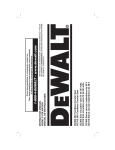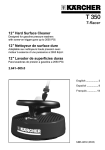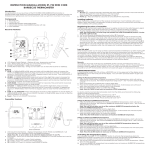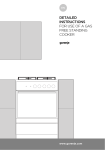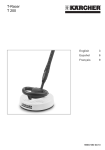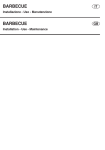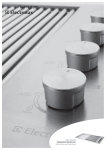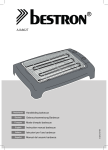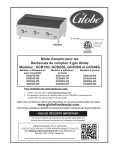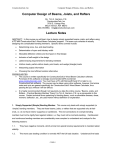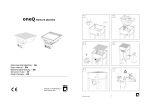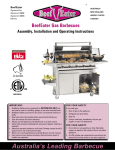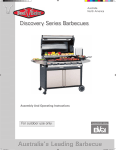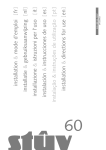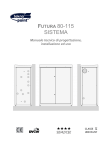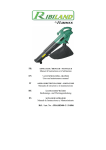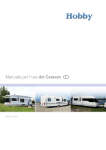Download Scarica il libretto di istruzioni
Transcript
SUPREME OUTDOOR SBQ 1000 G Complimenti Complimenti e grazie per aver scelto il nostro barbecue integrato. Siamo sicuri che sarà per voi un piacere usare il nostro nuovo barbecue. Prima di usare il barbecue, raccomandiamo di leggere tutto il manuale utente, che fornisce la descrizione del barbecue e delle relative funzioni. Per evitare quei rischi sempre presenti durante l’uso di un apparecchio a gas, è importante installarlo correttamente e leggere attentamente le istruzioni per la sicurezza, al fine di evitare usi impropri e pericoli. Raccomandiamo di conservare questo libretto di istruzioni per consultazioni future e di consegnarlo ad eventuali proprietari successivi. Dopo aver tolto il barbecue dall’imballaggio, controllare che non sia danneggiato. In caso di dubbio, non usare l’apparecchio e contattare il più vicino centro di assistenza clienti. I Italiano GB English Sommario Descrizione del prodotto..................................4 Componenti.................................................... 6 Istruzioni importanti per la sicurezza...............8 Montaggio del barbecue................................. 12 Caratteristiche del gas nei diversi paesi..........16 Informazioni di sicurezza della bombola del gas ................................................................ 25 Istruzioni di installazione................................. 26 Suggerimento per l’ambiente Allacciamento della bombola di gpl.................37 Informazioni sullo per gli utilizzatori Applicazione del coperchio sottile o della cappa di cottura ............................................. 39 • Istruzioni d’uso ............................................... 41 Pulizia e cura ..................................................45 Manutenzione ................................................ 50 • Risoluzione problemi ......................................51 3 smaltimento La maggior parte dei materiali di imballaggio è riciclabile. Questi materiali vanno smaltiti tramite l’apposito centro di riciclaggio locale o mettendoli in contenitori di raccolta adeguati. Se si desidera gettare il prodotto, contattare gli uffici locali competenti e informarsi sulla modalità di smaltimento corretta. I Descrizione del prodotto I 1 7 2 6 4 5 3 Barbecue integrato con coperchio sottile 1. 2. 3. 4. 5. 6. 7. 8. Coperchio sottile Coperchio vano batteria Punto di allacciamento del gas Comandi dei bruciatori Gruppi griglie (2 set) Piastra di cottura Vaschetta di raccolta olio amovibile collocata davanti al piano cottura (non illustrata) Diffusori di fiamma (2 pz.) collocati sotto le griglie (non illustrati) 4 I 10 9 11 16 15 13 14 12 Barbecue integrato coperchio alto 9. Coperchio alto 10.Rastrelliere di riscaldamento 11.Coperchio vano batteria 12.Punto di allacciamento del gas 13.Comandi dei bruciatori 14.Gruppo griglia 15.Piastra di cottura 16.Vaschetta di raccolta olio amovibile collocata davanti al piano cottura (non illustrata) 17.Diffusori di fiamma (2 pz.) collocati sotto le griglie (non illustrati) 5 Componenti DESCRIZIONE QTÀ Scatola bruciatori e profilo esterno 1 Bruciatori 4 Diffusori di fiamma 2 Vaschette per l’olio 2 I 6 I Piastra di cottura massiccia 1 Gruppi griglie 2 CONFIGURAZIONE 1 Coperchio Alto per cottura 1 CONFIGURAZIONE 2 Coperchio Basso di copertura 7 1 Istruzioni importanti per la sicurezza I Per la propria sicurezza, l’utente è tenuto a leggere questo manuale prima di mettere in funzione il barbecue. Utilizzazione Leggere attentamente il manuale utente e conservarlo in un luogo a portata di mano per esigenze di consultazione futura. Viene mostrato qui di seguito il significato dei simboli usati in questo manuale: ATTENZIONE Questo simbolo segnala informazioni relative alla sicurezza personale dell’utente AVVERTENZA Questo simbolo segnala informazioni sul modo di evitare danni all’apparecchio SUGGERIMENTI E INFORMAZIONI Questo simbolo segnala suggerimenti e informazioni sull’uso dell’apparecchio SUGGERIMENTO PER L’AMBIENTE Questo simbolo segnala informazioni per un uso economico ed ecologico dell’apparecchio Questo simbolo segnala il divieto di compiere un’azione ATTENZIONE L’apparecchio DEVE essere installato e riparato solamente da personale qualificato e patentato. L’installazione, la modifica delle regolazioni o la manutenzione effettuate in modo improprio possono causare lesioni o danni a cose. Del caso contattate il più vicino Centro di Assistenza Tecnica per avere ulteriori informazioni. 8 NOTA PER L’INSTALLATORE: IL PRESENTE MANUALE DEVE RESTARE AL PROPRIETARIO PER CONSULTAZIONE FUTURA ATTENZIONE SE SI SENTE ODORE DI GAS, non cercare di accendere il barbecue. Eseguire la procedura di prova fughe come descritta nel manuale. Localizzare la fuga e riserrare il raccordo che perde se quello della bombola sostituendo casomai anche la guarnizione di tenuta. Se la fuga persiste, chiudere l’alimentazione di gas e chiamare l’assistenza tecnica. Non piegarsi sul barbecue durante l’accensione. Non lasciare il barbecue incustodito quando è acceso. Non ritardare l’accensione una volta aperto il gas. Non tenere o usare bombolette spray in prossimità del barbecue. Non tenere liquidi infiammabili in prossimità del barbecue. Non usare detergenti a base caustica o abrasiva sul barbecue. Non mettere in funzione il barbecue con il coperchio chiuso. Non cercare di smontare o sistemare i rubinetti di comando. Non cercare di smontare o sistemare il regolatore della bombola (non in dotazione) ma eventualmente sostituirlo con uno nuovo. Non verificare la presenza di fughe con una fiamma libera. Non modificare la struttura dell’apparecchio e non modificare le dimensioni dell’orificio degli iniettori. Non ostruire le aperture di ventilazione del barbecue. Non permettere ai bambini di mettere in funzione il barbecue o di giocare vicino ad esso Non utilizzare il barbecue se nel raggio di circa 60 cm dalla parte superiore, inferiore, posteriore o laterale del dispositivo si trovano materiali infiammabili. 9 I I Tenere eventuali cavi elettrici e tubi di alimentazione carburante lontano dalle superfici calde. Non tenere mai una bombola di gas di ricambio vicino al barbecue Questo dispositivo raggiunge temperature elevate. Prestare particolare attenzione in presenza di bambini o anziani Non spostare l’apparecchio quando è acceso Indossare guanti di protezione durante l’utilizzo del babecue Tenere lontani i bambini di età inferiore agli otto anni se non continuamente sorvegliati. Non tentare mai di spegnere una fiamma/incendio con acqua: spegnere l’apparecchio e coprire la fiamma con un coperchio o con una coperta ignifuga. Maneggiare con cura le bombole di gas anche se sembrano vuote nel rispetto delle norme sulla sicurezza in uso. Non utilizzare bombole di gas ammaccate o arrugginite Non scollegare la bombola di gas dall’apparecchio quando è in funzione. Eseguire qualsiasi intervento sulla bombola di gas lontano dall’apparecchio. Accendere i bruciatori solamente a coperchio sollevato Se la manopola diventa difficile da ruotare, fare controllare i rubinetti da un centro assistenza autorizzato. Abbassare il coperchio accompagnandolo con la mano facendo in modo che nulla si interponga alla sua corretta chiusura. Durante la cottura a coperchio chiuso tenete sotto controllo il termometro: e se il valore supera i 350°C è necessario sollevare il coperchio per evitare pericolosi surriscaldamenti. Non lasciare oggetti sulle superfici di cottura. Non usare in nessun caso l’apparecchio per riscaldare l’ambiente. Chiudere sempre la valvola gas della bombola a fine utilizzo. 10 Responsabilita’ del costruttore: I Il costruttore declina ogni responsabilità per danni subiti da persone e cose causati da: • uso dell’apparecchio diverso da quello previsto; • inosservanza delle prescrizioni del manuale d’uso; • manomissione anche di una singola parte dell’apparecchio; • utilizzo di ricambi non originali. 11 Montaggio del barbecue I Utensili necessari per il montaggio: - cacciavite con intaglio a croce 1. Togliere tutti i componenti dalla scatola. RETRO FRONTE 2. Collocare i diffusori di fiamma nelle posizioni desiderate (sotto i punti (A) nei quali verranno messe le sezioni di griglia) e attaccare il bordo posteriore del diffusore di fiamma al retro del corpo del barbecue. FRONTE RETRO 12 I RETRO 3. Applicare le vaschette di raccolta olio alla parte anteriore del barbecue. RETRO FRONTE 13 4. Mettere la piastra di cottura e le sezioni di griglia nelle posizioni desiderate accertandosi che i diffusori di fiamma si trovino sotto le sezioni di griglia NOTA: assicurarsi che i gruppi griglie siano orientati correttamente, in modo che la superficie della griglia sia inclinata in avanti per permettere all’olio di defluire nelle vaschette di raccolta. I RETRO FRONTE 14 5. Dopo l’installazione nel banco, collegare il coperchio sottile o la cappa di cottura come descritto nel capitolo “Applicazione del coperchio sottile o della cappa di cottura” del presente manuale. I RETRO FRONTE FRONTE DETTAGLIO H 15 Caratteristiche dei gas nei diversi paesi CATEGORIA GAS E PRESSIONI I PAESI DI DESTINAZIONE AT BE CY HR DK EE FI FR DE GR IE I3+ G30/G31=28-30/37 mbar I3B/P(30) G30/G31=30mbar I3B/P(37) G30/G31=37mbar I3B/P(50) G30/G31=50mbar • 2H G20=20mbar • 2E G20=20mbar 2E+ G20=20mbar 2L G25=25mbar 2LL G25/20mbar 2H(25) G20/25mbar 2S G25.1/25mbar 2Lw G27/20mbar 2Ls G2.350/13mbar CATEGORIA • • • • • • • • • IS • • IT LV LT LU • • • • • • • • • • • • • • • • • • • • • • GAS E PRESSIONI PAESI DI DESTINAZIONE MT NO NL PT PL GB CZ RO SK SI ES SE CH TR HU I3+ G30/G31=28-30/37 mbar I3B/P(30) G30/G31=30mbar I3B/P(37) G30/G31=37mbar I3B/P(50) G30/G31=50mbar 2H G20=20mbar 2E G20=20mbar 2E+ G20=20mbar 2L G25=25mbar 2LL G25/20mbar 2H(25) G20/25mbar • • • • • • • • • • • • • • • • • • • • • • • • • • • • • • • • • • • • • • • 2S G25.1/25mbar 2Lw G27/20mbar • • 2Ls G2.350/13mbar • 16 G20-20 cat. 2H, 2E, 2E+ Portata termica nominale (kW) Diametro iniettore (1/100mm) Numero iniettori Pressione (mbar) Consumo massimo (l/h) Regolazione aria primaria (mm) X vedi fig. pag. 21 15,2 135 4 20 1448 1 G20-25 cat. 2H(25) Portata termica nominale (kW) Diametro iniettore (1/100mm) Numero iniettori Pressione (mbar) Consumo massimo (l/h) Regolazione aria primaria (mm) X vedi fig. pag. 21 15,2 130 4 25 1448 1 G25-20 cat. 2LL Portata termica nominale (kW) Diametro iniettore (1/100mm) Numero iniettori Pressione (mbar) Consumo massimo (l/h) Regolazione aria primaria (mm) X vedi fig. pag. 21 15,2 155 4 20 1684 1 G25-25 cat.2L Portata termica nominale (kW) Diametro iniettore (1/100mm) Numero iniettori Pressione (mbar) Consumo massimo (l/h) Regolazione aria primaria (mm) X vedi fig. pag. 21 15,2 145 4 25 1684 1 G25.1 cat.2S Portata termica nominale (kW) Diametro iniettore (1/100mm) Numero iniettori Pressione (mbar) Consumo massimo (l/h) Regolazione aria primaria (mm) X vedi fig. pag. 21 17 15,2 145 4 25 1683 1 I G27 cat.2Lw I Portata termica nominale (kW) Diametro iniettore (1/100mm) Numero iniettori Pressione (mbar) Consumo massimo (l/h) Regolazione aria primaria (mm) X vedi fig. pag. 21 15,2 155 4 20 1766 1 G2.350 cat.2Ls Portata termica nominale (kW) Diametro iniettore (1/100mm) Numero iniettori Pressione (mbar) Consumo massimo (l/h) Regolazione aria primaria (mm) X vedi fig. pag. 21 15,2 194 4 13 2011 1 G30 /G31 cat. I3+ Portata termica nominale (kW) Diametro iniettore (1/100mm) Numero iniettori Pressione (mbar) Consumo massimo (g/h) Regolazione aria primaria (mm) X vedi fig. pag. 21 G30 /G31 cat. I3B/P (30) Portata termica nominale (kW) Diametro iniettore (1/100mm) Numero iniettori Pressione (mbar) Consumo massimo (g/h) Regolazione aria primaria (mm) X vedi fig. pag. 21 G30 /G31 cat. I3B/P (37) Portata termica nominale (kW) Diametro iniettore (1/100mm) Numero iniettori Pressione (mbar) Consumo massimo (g/h) Regolazione aria primaria (mm) X vedi fig. pag. 21 18 15,2 94 4 28..30/30..37 1106 Tutto aperto 15,2 94 4 30 1106 Tutto aperto 15,2 89 4 37 1106 Tutto aperto G30 /G31 cat. I3B/P (50) Portata termica nominale (kW) Diametro iniettore (1/100mm) Numero iniettori Pressione (mbar) Consumo massimo (g/h) Regolazione aria primaria (mm) X VEDI FIG. PAG. 21 15,2 83 4 50 1106 Tutto aperto Adattamento a diverso tipo di gas Se l’apparecchiatura risulta predisposta per un diverso tipo di gas da quello di alimentazione disponibile, si deve procedere alla sostituzione degli iniettori con i corrispondenti al tipo di gas da utilizzare (vedi tabelle pagine precedenti). La sostituzione va fatta usando un’apposita chiavetta da 7mm dopo aver tolto i bruciatori come nel modo indicato a pagina (47). Una volta sostituito l’iniettore provvedere a regolare l’Aria dello stesso portandolo a 1mm se per metano e al massimo se a GPL. Per la regolazione del minimo, una volta acceso il bruciatore, tolto la manopola e la guarnizione sotto, ruotare l’apposita vite del rubinetto (B - vedi pag. 21) che per il GPL va totalmente chiusa mentre per il metano deve essere svitata per circa 3/4 di giro ricordando che una fiamma più bassa di 3mm può anche non venire “sentita” dalla termocoppia del rubinetto. Una volta regolati i minimi, rimontare le guarnizioni e le manopole relative. FRONTE RETRO 19 I I DETTAGLIO A FRONTE RETRO FRONTE RETRO 20 I B B X NOTE • L’apparecchio DEVE essere installato e riparato solamente da personale qualificato e autorizzato. • Il prodotto è destinato esclusivamente all’uso esterno. • Il prodotto deve essere installato seguendo le istruzioni, che richiedono delle aperture di ventilazione per permettere al barbecue di funzionare correttamente. La mancanza di un’adeguata ventilazione che fornisca l’alimentazione di aria all’apparecchio può portare ad una scarsa efficienza dei bruciatori o all’eccessivo sviluppo di calore all’interno del vano di installazione. • Le aperture di ventilazione dell’unità non devono essere coperte durante l’installazione. 21 Collegamento gas Collegare l’apparecchiatura alla bombola o all’impianto secondo le prescrizioni delle norme in vigore accertandosi preventivamente che l’apparecchiatura sia predisposta al tipo di gas disponibile. In caso contrario vedi: “Adattamento a diverso tipo di gas”. Verificare inoltre che la pressione di alimentazione rientri nei valori riportati nella tabella: “Caratteristiche del gas”. I Allacciamento metallico rigido/semirigido/tubo in gomma Eseguire l’allacciamento con raccordi e tubi metallici (anche flessibili) in modo da non provocare sollecitazioni agli organi interni all’apparecchio. Il collegamento con tubo in gomma conforme alla norma vigente può essere realizzato solamente se il tubo è ispezionabile in tutta la sua lunghezza agevolmente sostituibile in prossimità della scadenza indicata sul tubo stesso. N.B. - Ad installazione ultimata controllare, con una soluzione saponosa, la perfetta tenuta di tutto il sistema di collegamento. NON UTILIZZARE FIAMME LIBERE PER IL CONTROLLO DI TENUTA GAS 22 Dettaglio di allacciamento del gas I 50 490 45 EN 10226-1, EN 10226-2 EN ISO 228-1 23 I Con nota: collegamento gas naturale GN. 24 Informazioni di sicurezza in merito alle bombole del gas • L’apparecchio, una volta fatta la conversione per l’uso di GPL, è progettato per utilizzare diversi tipi di bombola di gas a seconda dell’installazione fatta. Vedi capitoli relativi all’Installazione, Preparazione e Allacciamento della bombola. • La bombola del gas deve essere fabbricata e marcata in accordo alle specifiche per le bombole di GPL in uso nel paese. • La valvola di isolamento deve essere chiusa quando l’apparecchio non viene usato. • Le bombole di gas devono essere tenute in un alloggiamento appropriato fuori della portata dei bambini. • Quando si scollega la bombola del gas, assicurarsi che i rubinetti di comando siano in posizione di chiuso (O). • Prima di scollegarla, togliere la bombola dall’alloggiamento in cui eventualmente si trova. • Quando si ricollega il tubo alla bombola, assicurarsi che tutti i collegamenti siano a tenuta prima di riposizionarla nell’apposito compartimento. • Eseguire un controllo delle fughe come descritto di seguito dopo ogni collegamento di una nuova bombola. Procedura di prova fughe • Accertarsi che tutti i rubinetti del gas siano in posizione di chiuso (O). • In un piccolo contenitore, mescolare una soluzione di acqua e detergente o sapone. • Dopo il collegamento del tubo, aprire la valvola sulla bombola del gas o eventualmente il rubinetto di rete. • Usando un pennello, applicare la soluzione sui punti di collegamento del gas e controllare se c’è formazione di bolle. • La presenza di bolle indica una fuga. • Chiudere la valvola e riserrare il raccordo magari inserendo una nuova guarnizione. Ripetere la prova fughe. • Se la fuga persiste, chiudere il gas e contattare un manutentore autorizzato e patentato di impianti a gas per rimediare alla fuga. 25 I Istruzioni di installazione e avvertenze I ATTENZIONE • L’apparecchio deve essere usato soltanto sopra la superficie del suolo, in condizioni di aria aperta con ventilazione naturale e senza aree stagnanti, dove le fughe di gas e i prodotti di combustione vengono rapidamente dispersi dal vento o dalla convezione naturale. Questo barbecue è stato progettato solo per uso esterno. Fare riferimento ai disegni sottostanti. • Non installare mai il barbecue all’interno di edifici, garage, baracche o passaggi coperti oppure all’interno di imbarcazioni, camper o caravan. Ciò serve a prevenire il possibile sviluppo di incendi o di monossido di carbonio con effetti tossici o di asfissia. • Il vano in cui l’apparecchio viene installato deve essere conforme ad uno dei seguenti requisiti: • Un vano con pareti su tutti i lati, ma con almeno un’apertura permanente a livello del suolo e senza copertura superiore. • All’interno di un vano parziale che comprende una chiusura superiore e non più di 2 pareti. • All’interno di un vano parziale che comprende una copertura superiore e più di 2 pareti; in questo caso si applica il seguente principio: • Almeno il 25% della superficie totale delle pareti è completamente aperto e almeno il 30% della superficie rimanente delle pareti è aperto e libero • In caso di balconi, almeno il 20% della superficie totale delle pareti laterali, posteriori e anteriori deve essere e restare aperto e libero. Superficie esterna esempio 1 Superficie esterna esempio 2 Superficie esterna esempio 3 entrambe le estremità aperte 26 Superficie esterna esempio 4 I lato aperto per almeno il 25% del- in totale il 30% o più della superla superficie totale delle pareti ficie restante delle pareti è aperto e libero Superficie esterna esempio 5 lato aperto per almeno il 25% del- in totale il 30% o più della superla superficie totale delle pareti ficie restante delle pareti è aperto e libero Scelta del punto di collocazione • L’apparecchio non deve essere installato su materiale combustibile. La distanza minima da materiali combustibili è di 600 mm. • L’altezza libera sopra il piano cottura rispetto a materiali combustibili deve essere di almeno 600 mm. • L’apparecchio deve essere installato in conformità alle norme e in accordo con le deviazioni locali. • Durante l’uso di GPL all’interno di un vano deve essere garantita la ventilazione. Il gas è altamente esplosivo e può causare gravi lesioni e danni a cose se lo si lascia accumulare e poi si infiamma. • Il barbecue è destinato ad essere montato in un TOP con profondità minima minima di 600 mm. • Evitare le posizioni esposte al vento poiché potrebbero risentirne la cottura e l’efficienza dei bruciatori. Se non si può evitare una simile posizione, possono essere necessari degli schermi. Vano di installazione • Il barbecue richiede una barriera non combustibile sotto di esso per impedire che si raggiunga una temperatura eccessiva in ottemperanza della Norma UNI EN 498 in vigore. Il pannello che funge da barriera deve essere posizionato 30 mm al di sotto della base 27 I dell’unità. • Il vano di installazione deve essere realizzato con materiali non combustibili. Tra i materiali adatti per la costruzione vi sono muratura, granito, marmo, Hardiplank®, Villaboard®, utilizzati su una struttura di metallo o su laterizi. • L’apparecchio richiede la presenza di aperture di ventilazione nella parete anteriore del vano. Si veda il disegno sottostante per i dettagli. • L’apparecchio può essere montato sia in un banco tipo isola che in un banco dotato di paraspruzzi. Leggere i requisiti specifici per ciascun tipo di montaggio. Installazione stile isola • Se l’apparecchio viene installato in una montatura ad isola, può essere collocato in posizione centrale. Fare particolare attenzione alle dimensioni d’ingombro del top dell’isola tenendo conto della cappa di cottura aperta e della sporgenza. Vedere pag. 29. • Le dimensioni richieste foro di inserimento sono di 1025 mm x 502 mm (vedere disegno). Installazione in un Top inserito in un’apposito contesto • Il contesto deve essere realizzato in materiale non combustibile. • In caso di montaggio dell’apparecchio contro una parete o una recinzione, è fondamentale aver cura di assicurare l’isolamento dei materiali combustibili. Tutti i materiali combustibili devono essere tenuti almeno 600 mm lontano dal barbecue. • La profondità minima della superficie di montaggio (TOP) è di 600 mm • Le dimensioni richieste della foratura sono di 1025 mm x 505 mm (vedere disegno). • Per i modelli con coperchio alto di cottura è richiesto una spazio libero specifico sul retro del barbecue tra lo schienale e la foratura del top, pari ad almeno 70 mm. Questo affinché il coperchio alto disponga dello spazio libero necessario per aprirsi. 28 Per facilitare l’inserimento nel mobile, il prodotto e’ provvisto di apposite maniglie di sollevamento (vedi figura sotto) I DX SX B Parete 52 FRONTE 70 Top 29 Parete I 55,5 +10 0 FRONTE Top 177 70 +10 0 505 30 177 I 505 FRONTE ATTENZIONE • L’apparecchio richiede un’adeguata ventilazione. Deve essere prevista una superficie aperta come indicato sotto. Può essere applicata una grata di aerazione se lo si desidera. Questa superficie di ventilazione consente l’ingresso dell’aria nel vano per la corretta combustione dei gas e per la corretta aspirazione dei prodotti di combustione. Nel caso del GPL, il gas è più pesante dell’aria; nell’eventualità di una fuga la bocchetta di ventilazione fa sì che il gas fuoriesca dal vano. La bocchetta di ventilazione deve essere minimo di 700 mm x 25 mm e collocata in posizione centrale 135 mm sotto la superficie di montaggio. (vedere disegno). 31 I 505 102 5 apertura importante per areazione grigle o fori d'areazione Installazione stile isola 32 I ATTENZIONE • La bombola di GPL nel vano sotto l’unità barbecue, deve essere isolata dalla stessa per mezzo di un pannello non combustibile. Il vano deve essere conforme ai requisiti della EN 498. • I requisiti di ventilazione previsti dalla EN 498 per il ricovero delle bombole sono: • In caso di struttura in lamiera o struttura simile impenetrabile, devono esserci aperture di ventilazione sulla parte superiore e sul fondo del vano o della cavità, ognuna delle quali deve fornire una superficie libera di almeno 200 cm2 per ogni bombola alloggiata le bocchette B servono inoltre come punto di ispezione nell’eventualità si usasse un tubo in gomma. 210 distanza minima dalla parete 55mm 30 min 20 mm lunghezza max 1,5 metri 33 I 210 mm min 300 mm min 300 mm MAX 1,5 mt 34 I barriera non combustibile necessaria sotto il barbecue tagliare un foro nella barriera non combustibile solo per il tubo parte frontale del vano rimossa per chiarezza La bombola di GPL puo essere collegata all’interno del vano portaoggetti del barbecue solo se ha le dimensioni indicate nelle linee guida. L’utilizzo sicuro di una bombola all’interno del vano portaoggetti del mobile che sostiene il barbecue dipende da diversi fattori: A) La base della bombola deve essere inserita correttamente tra le piastre e trovarsi in posizione orizzontale sul pannello di base. Dimensioni della bombola Altezza max 465 mm Larghezza 289 mm - (sezione rettangolare) o 318 mm (sezione circolare) massimo B) Capacità della bombola max 6 kg Sono disponibili diversi modelli di bombole di dimensioni approvate (2). AVVERTENZA: se la bombola di GPL acquistata non presenta le dimensioni richieste, non tentare di collegarla all’interno del vano portaoggetti. Fissare la bombola sulla staffa oppure posizionarla a terra. Il mancato rispetto di queste istruzioni potrebbe danneggiare il tubo con conseguenti incendi o esplosioni e causare lesioni gravi o mortali e danni alle cose. 35 I 36 Allacciamento della bombola di gpl Avvertenza: Assicurarsi che la valvola della bombola GPL o del regolatore sia chiusa. A) Collegare la bombola di GPL. Alcuni regolatori si collegano premendo ON e si scollegano tirando OFF, mentre altri tipi di regolatori sono muniti di dado con filettatura sinistra per il collegamento alla valvola della bombola. Seguire le illustrazioni delle istruzioni di collegamento specifiche per il regolatore. a) Avvitare il regolatore alla bombola ruotando in senso antiorario (1). Installare il regolatore in modo che il foro di sfiato (2) sia rivolto verso il basso. b) Avvitare il regolatore alla bombola ruotando in senso antiorario (3) (4). c) Assicurarsi che la leva del regolatore (5) sia abbassata o in posizione off. Premere il regolatore sulla valvola della bombola fino a che non si avverte lo scatto che indica l’avvenuto posizionamento (6). d) Assicurarsi che la leva del regolatore sia in posizione off. Alzare la ghiera del regolatore (7). Premere il regolatore sulla valvola della bombola e tenere premuto. Abbassare la ghiera (8). Se il regolatore non si blocca, ripetere la procedura. 37 I Applicazione del coperchio sottile I Applicazione del coperchio basso • Togliere il coperchio sottile dall’imballaggio. • Applicare le cerniere alla cornice esterna e fissarle con le apposite vite in dotazione. DETTAGLIO B SINISTRO DESTRO 38 Applicazione del coperchio alto • Togliere il coperchio alto dall’imballaggio. • Estrarre la cerniera dal coperchio ed applicarla alla cornice esterna. Fissarla con le apposite viti in dotazione. • Inserire il coperchio nelle apposite sedi della cerniera (vedi dettaglio A pag. 40). IMPORTANTE • Date le dimensioni della cappa di cottura, si consiglia che venga messa in posizione da due persone. • Durante il posizionamento del gruppo coperchio alto, fare particolare attenzione ad evitare di graffiare il profilo esterno. DETTAGLIO C 39 I I A DETTAGLIO A 40 Istruzioni d’uso I IMPORTANTE Assicurarsi che i diffusori di fiamma siano posizionati sotto i pannelli delle griglie Piastra di cottura a sinistra, griglia a destra – orientamento migliore per grigliare Mezza griglia sinistra, piastra di cottura centrale, mezza griglia a destra – orientamento migliore per arrostire 41 I Griglie a sinistra, piastra di cottura a destra – orientamento migliore alternativo per grigliare Funzioni di controllo Prima di accendere il barbecue: • Controllare che tutti i tubi e raccordi del gas siano a tenuta. • Aprire il coperchio sottile o quello alto. NOTA: Il coperchio sottile è progettato come copertura per proteggere dagli agenti atmosferici. Il coperchio non è concepito per essere usato come cappa di cottura. • Controllare che tutte le manopole di comando siano in posizione di chiuso (O). • Assicurarsi che le superfici di cottura siano pulite. • Aprire la valvola di adduzione generale del gas. Istruzioni di accensione • Non accendere i bruciatori con i piani cottura coperti. • Per accendere un bruciatore, premere la manopola e girarla in posizione ‘MAX’ (preriscaldamento rapido). • Tenerla premuta per 5 secondi (contare fino a dieci), rilasciarla e controllare la fiamma dalle feritoie sul davanti. • Se il bruciatore non si è acceso, girare la manopola in posizione di chiuso (O). Lasciare che il gas si disperda, quindi ripetere la procedura di accensione. OFF MAX MIN 42 Accensione manuale • Nel caso in cui il sistema automatico di accensione non funzionasse, il barbecue può essere acceso manualmente. • Per accenderlo manualmente, utilizzare un fiammifero lungo (28cm). Togliere momentaneamente la vaschetta per l’olio e far passare il fiammifero acceso tra le fessure di ispezione sotto la parte anteriore delle piastre di cottura, avvicinandolo al bruciatore, quindi girare la manopola e tenerla premuta sul MAX (preriscaldamento rapido) per effettuare l’accensione. Se l’accensione non si verifica, chiudere la valvola di comando e attendere per alcuni minuti che il gas si disperda prima di tentare di nuovo di accendere il barbecue. • Una volta acceso un bruciatore, ripetere la procedura per gli altri se necessario. Fessure di controllo Preriscaldamento zone di cottura • Questo barbecue è equipaggiato con bruciatori ad alta potenza. Nella maggior parte delle condizioni sarà necessario preriscaldare il barbecue solo per 5 minuti prima che si possa iniziare la cottura. • Come per la maggior parte delle cose, attraverso l’esperienza maturata l’utente acquisisce dimestichezza con l’efficacia e con l’intervallo necessario al raggiungimento del tempo di preriscaldamento migliore per ottenere la temperatura di cottura ideale. Non dimentichiamo che ciò dipende anche dal tipo di cibo, dal suo spessore e da come lo vogliamo cuocere. • I test hanno dimostrato che si può abbassare la fiamma dei bruciatori per una cottura soddisfacente. • Se il barbecue è dotato di un coperchio sottile, è consigliabile rimuoverlo in presenza di vento. • Se l’unità non funziona correttamente, consultare il capitolo “Risoluzione dei problemi”. • Se si lascia che le zone di cottura si surriscaldino, si svilupperà fumo in eccesso durante la fase di cottura, con conseguente bruciatura del cibo che viene cucinato. 43 I I • Per arrostire con il coperchio alto chiuso è sufficiente che i 4 bruciatori siano regolati alla minima potenza (MIN) per cuocere in modo soddisfacente Per spegnere il bruciatore • Quando la cottura è terminata, girare completamente la manopola in senso orario in modo che l’indice sulla manopola sia in posizione di chiuso (O). Ricordarsi di chiudere sempre la valvola gas della bombola a fine utilizzo. L’utilizzatore si ricordi di escludere il gas prima di chiudere il coperchio. ATTENZIONE IL COPERCHIO SOTTILE NON DEVE ESSERE CHIUSO QUANDO I BRUCIATORI SONO IN FUNZIONE. Se il coperchio viene chiuso mentre i bruciatori sono in funzione si può provocare lo scolorimento e il danneggiamento del coperchio e del barbecue. 44 Pulizia e cura Pulizia e cura dell’apparecchio I Perché il barbecue mantenga l’aspetto originario si consiglia di pulire le zone cottura dopo ogni utilizzo. ATTENZIONE Assicurarsi che il barbecue sia spento e si sia raffreddato prima di eseguire le istruzioni riportate di seguito. Pulizia delle parti in acciaio inossidabile • Togliere dalla griglia e dalla piastra di cottura tutti i materiali solidi e il grasso in eccesso usando un raschietto o una spazzola metallica • Per facilitare la pulizia, le due metà della griglia possono essere rimosse con la piastra di cottura. Per le macchie ostinate, immergere semplicemente le parti della griglia e la piastra in acqua calda saponata prima di risciacquarle con cura • Assicurarsi che tutte le superfici vengano asciugate con un panno pulito e asciutto Altre superfici in acciaio inossidabile AVVERTENZA Non usare detergenti abrasivi o caustici, pagliette o raschietti metallici su queste superfici in acciaio inossidabile, perché possono graffiare e danneggiare in permanenza il barbecue. • Lavare tutte le parti in acciaio inossidabile, compresi il coperchio sottile, coperchio alto e le manopole di comando, con uno strofinaccio morbido usando acqua calda saponata • L’interno del barbecue può essere pulito con un panno morbido bagnato in acqua calda saponata. Il pannello posteriore dell’interno è asportabile per una facile pulizia • Assicurarsi che tutte le superfici vengano asciugate con un panno pulito e asciutto AVVERTENZA Fare particolare attenzione (in special modo quando si pulisce sulle manopole e attorno ad esse) ad evitare che acqua e residui di sapone entrino nel pannello di controllo in cui si trovano i rubinetti o nei bruciatori. Fare attenzione anche a non toccare l’elettrodo di accensione e termocoppia. Tra l’elettrodo e i bruciatori deve essere mantenuta una distanza di 3 mm (vedere disegno pagina seguente). 45 I 3 3 +1,5- 0 Pulizia delle vaschette di raccolta olio Il barbecue integrato ha un sistema unico di gestione dell’olio, che usa canali sovrapposti per convogliare tutto l’olio verso la parte anteriore in vaschette di raccolta facilmente amovibili, che devono essere pulite dopo ogni utilizzo. • Per estrarre le vaschette, tirarle verso l’alto dalla parte anteriore del barbecue; smaltire poi il contenuto raccolto in modo responsabile. Lavare le vaschette di racolta in acqua calda saponata o, se volete, potete metterle in lavastoviglie. Bruciatori I bruciatori vanno controllati almeno una volta all’anno e puliti se necessario. Ispezionare i bruciatori per accertarsi che non si siano depositati dei residui e che gli attacchi del gas siano liberi. 46 Di seguito si riportano le sequenze per estrarre e pulire i bruciatori. - svitare la vita a farfalla di fissaggio del bruciatore -sollevare leggermente il bruciatore - abbassare il bruciatore facendolo rientrare verso l’interno il bruciatore 47 I I sollevare il bruciatore ed estrarlo. Una volta pulito ricollocare nella sua sede il bruciatore percorrendo a ritroso la procedura appena eseguita finendo con il bloccarlo con la vite a farfalla in dotazione. 48 I SUGGERIMENTI E INFORMAZIONI Nota speciale sulla “colorazione tè” Talvolta le superfici di acciaio inossidabile sono affette da un’alterazione cromatica chiamata “colorazione tè”. Questa si verifica solitamente nelle zone in cui si impiega un calore molto forte e può essere facilmente rimossa usando detergenti specifici per l’acciaio inossidabile. Per ottenere i risultati migliori, si consiglia di usare regolarmente detergenti specifici su tutte le parti in acciaio inossidabile. Questi detergenti sono disponibili in quasi tutti i negozi di ferramenta ma anche nei supermercati. Nota speciale sull’acciaio inossidabile I pannelli di acciaio inossidabile possono deformarsi durante l’uso ma riprendono la forma normale una volta raffreddati. 49 Manutenzione I Sistema di accensione Per cambiare la batteria togliere il coperchio copri batteria (dettaglio G) sollevare lo sportellino del porta batteria ed estrarre la batteria. Sostituirla con una batteria D nuova e riposizionare il coperchio. Fare una prova premendo la manopola; si dovrebbe udire un clic sonoro. G DETTAGLIO G Aperture di ventilazione Le aperture di ventilazione del vano di installazione devono essere controllate prima di ogni utilizzo dell’apparecchio, per assicurarsi che non presentino ostruzioni che possono ostacolare il libero flusso dell’aria. 50 Risoluzione dei problemi PROBLEMA CAUSA POSSIBILE RIMEDIO Il barbecue non si accende Assenza di gas Controllare che la valvola di isolamento sia aperta (ON) Bombola del gas vuota - riempire o cambiare la bombola Il sistema di accensione non funziona Controllare la batteria – si dovrebbe udire un clic sonoro quando si preme la manopola Sostituire la batteria Accendere il barbecue manualmente Rubinetto del gas regolato troppo alto Pulire e asciugare delicatamente l’elettrodo assicurandosi che la posizione sia corretta Fumo eccessivo emesso dalla superficie di cottura Valvola del gas regolata troppo alta Abbassare il gas o spegnere alcuni bruciatori Odore di gas NON CERCARE DI ACCENDERE L’PPARECCHIO Fuga di gas Chiudere il gas con le valvole di isolamento Verificare se ci sono fughe, stringere i raccordi Se il problema persiste chiamare l’assistenza 51 I DICHIARAZIONE DEL PRODUTTORE Con la presente il produttore dichiara che i prodotti di questo catalogo rispondono, a secondo delle tipologie, ai requisiti fondamentali richiesti dalle Direttive Europee e perciò il prodotto è stato contrassegnato col marchio CE e per esso è stata emessa la dichiarazione di conformità, a disposizione degli organi preposti al controllo del mercato. SMALTIMENTO DEGLI APPARECCHI USATI Al termine del periodo di utilizzo è vietato smaltire questi apparecchi elettrodomestici con i normali rifiuti urbani, deve bensì essere consegnato al punto di raccolta e riciclaggio delle apparecchiature elettriche ed elettroniche. Ne informa il simbolo riportato sul prodotto, sul manuale di istruzioni o sull’imballaggio. I materiali impiegati nell’apparecchio possono essere riutilizzati in conformità alla loro destinazione. Grazie al riutilizzo, al riciclo dei materiali o ad altre forme di riutilizzo degli apparecchi inservibili, darete il Vostro contributo alla protezione del nostro ambiente naturale. Le informazioni relative ai punti di smaltimento degli apparecchi inservibili vi saranno fornite dalle competenti autorità territoriali. Il produttore declina ogni responsabilità per inesattezze contenute nel presente catalogo a causa di errori tipografici. Ci riserviamo il diritto di apportare delle modifiche migliorative o indispensabili ai prodotti senza alterarne le specifiche essenziali. I prodotti possono subire delle modifiche a seguito di richieste migliorative e normative CE. SERVIZIO ASSISTENZA TECNICA: 199.151.195 Congratulations Congratulations and thanks for choosing our integrated barbecue. We are confident that it will be a pleasure for you to use our new barbecue. Before using the barbecue, we recommend reading the entire user guide, which provides a description of the barbecue and its functions. To avoid those risks that are always present when using a gas appliance, it is important to install it correctly and carefully read the safety instructions in order to avoid misuse and hazards. We recommend you keep this instruction booklet for future reference and pass it to any subsequent owners. After removing the barbecue from its packaging, check to see that it is not damaged. If in doubt, do not use the appliance and contact your nearest customer service centre. I Italiano GB English Contents Product description..........................................54 Components....................................................56 Important safety instructions........................... 58 Assembling the barbecue................................61 Characteristics of gas in different countries.... 65 Gas cylinder safety information.......................74 Installation instructions....................................75 Suggestion for the environment Disposal information for users Connection of the LPG cylinder.......................86 Application of the thin cover or cooking hood..87 Usage instructions...........................................90 Cleaning and care........................................... 94 • Maintenance....................................................99 Troubleshooting...............................................100 • 53 Most of the packaging material is recyclable. These materials should be disposed of through a local recycling centre or by putting them in appropriate collection containers. If you want to discard the product, contact your local authorities and ask about the correct method of disposal GB Product description GB 1 7 2 6 4 5 3 Integrated barbecue with thin cover 1. 2. 3. 4. 5. 6. 7. 8. Thin cover Battery compartment cover Gas connection point Burner controls Grill groups (2 sets) Cooking plate Removable oil collection drip plan located in front of the cooking surface (not shown) Flame diffusers (2 pcs.) located under the grills (not shown) 54 GB 10 9 11 16 15 13 14 12 Integrated barbecue high cover 9. High cover 10.Heating racks 11.Battery compartment cover 12.Gas connection point 13.Burner controls 14.Grill group 15.Cooking plate 16.Removable oil collection drip plan located in front of the cooking surface (not shown) 17.Flame diffusers (2 pcs.) located under the grills (not shown) 55 Components DESCRIPTION QTY GB 56 Burner box and external profile 1 Burners 4 Flame diffusers 2 Oil drip plans 2 Solid cooking plate 1 GB Grill groups 2 CONFIGURATION 1 High cover for cooking 1 CONFIGURATION 2 Low cover 57 1 Important safety instructions For your own safety, you should read this manual before operating the barbecue. Use GB Carefully read the user manual and keep it in a handy place for future reference. Below, we explain the meaning of the symbols used in this manual: ATTENTION This symbol indicates information relating to the user’s personal safety WARNING This symbol indicates information on how to prevent damage to the appliance TIPS AND INFORMATION This symbol indicates tips and information about the use of the appliance SUGGESTION FOR THE ENVIRONMENT This symbol indicates information for the economical and ecological use of the appliance This symbol indicates a prohibited action ATTENTION The appliance MUST only be installed and serviced by qualified and authorized personnel. Improper installation, modification, adjustment or maintenance can cause personal injury or property damage. Contact your nearest Service Centre for further information. NOTE FOR THE INSTALLER: THIS MANUAL MUST BE LEFT WITH THE OWNER FOR FUTURE REFERENCE 58 ATTENTION IF YOU SMELL GAS, do not try to light the barbecue. Perform the leak test procedure described in this manual. Locate the leak and tighten the leaking fitting; if it is the cylinder fitting, also replace the gasket seal. If the leak persists, turn off the gas supply and call for technical assistance. Do not lean over barbecue while lighting. Do not leave the barbecue unattended when it is on. Do not delay ignition once the gas is opened. Do not store or use aerosol sprays near the barbecue. Do not store inflammable liquids near the barbecue. Do not use abrasive or caustic detergents on the barbecue. Do not operate the barbecue with the cover closed. Do not attempt to disassemble or adjust the control valves. Do not attempt to disassemble or adjust the cylinder regulator (not supplied) but, if necessary, replace with a new one. Do not use an open flame to check for leaks. Do not modify the structure of the appliance and do not modify the dimensions of the injector orifice. Do not obstruct the ventilation openings of the barbecue. Do not allow children to operate the barbecue or play near it. Do not use the barbecue if inflammable materials are within a radius of about 60 cm from the top, bottom, rear or sides of the appliance. Keep any electrical wires and fuel hoses away from hot surfaces. Never store a spare gas cylinder near the barbecue. 59 GB This appliance reaches high temperatures. Be especially careful when children and elderly persons are present Do not move the barbecue when it is on. GB Wear protective gloves when using the barbecue. Keep children under the age of eight years away, if not constantly supervised. Never attempt to extinguish a flame/fire with water: turn off the appliance and cover the flame with a cover or a fire blanket. Be careful when handling gas cylinders even if they appear empty, in compliance with current safety rules. Do not use dented or rusty gas cylinders Do not disconnect the gas cylinder from the appliance when it is on. Perform any service on the gas cylinder far away from the appliance. Only turn the burners on with the cover lifted If the knob becomes difficult to rotate, have the taps checked by an authorized service centre. Lower the cover, accompanying it with your hand and make sure that nothing is obstructing its proper closure. When cooking with the cover closed keep an eye on the thermometer: if the temperature exceeds 350 °C, lift the cover to prevent dangerous overheating. Do not leave objects on the cooking surfaces. Never use the appliance to heat the area. Always close the valve of the gas cylinder after use. The manufacturer’s liability: The manufacturer will not be liable for personal injury or property damage caused by: • any use of the appliance other than anticipated; • failure to follow the instructions of the user manual; • tampering with any part of the appliance; • use of other than original parts. 60 Assembling the barbecue Tools needed for assembly: - Phillips screwdriver 1. Remove all components from the box. GB BACK FRONT 2. Place the flame diffusers in the desired positions (under the points (A) in which the grill sections will be placed) and attach the rear edge of the flame diffuser to the rear of the body of the barbecue. FRONT BACK 61 GB BACK 3. Apply the oil drip pans to the front of the barbecue. BACK FRONT 62 4. Place the cooking plate and grill sections in the desired positions, making sure that the flame diffusers are under the grill sections. NOTE: Make sure that the grill groups are correctly oriented so that the surface of the grill is tilted forward to allow the oil to drain into the drip pans. GB BACK FRONT 63 5. After installation in the counter, connect the thin cover or cooking hood area as described in the chapter “Application of the thin cover or cooking hood” in this manual. GB BACK FRONT FRONT DETTAGLIO H 64 Characteristics of gas in different countries CATEGORY GAS AND PRESSURES COUNTRIES OF DESTINATION AT BE CY HR DK EE FI FR DE GR IE I3+ G30/G31=28-30/37 mbar I3B/P(30) G30/G31=30mbar I3B/P(37) G30/G31=37mbar I3B/P(50) G30/G31=50mbar • 2H G20=20mbar • 2E G20=20mbar 2E+ G20=20mbar 2L G25=25mbar 2LL G25/20mbar 2H(25) G20/25mbar 2S G25.1/25mbar 2Lw G27/20mbar 2Ls G2.350/13mbar CATEGORY • • • • • • • • • IS • • IT LV LT LU • • • • • • • • • • • • • • • • • • • • • • GAS AND PRESSURES COUNTRIES OF DESTINATION MT NO NL PT PL GB CZ RO SK SI ES SE CH TR HU I3+ G30/G31=28-30/37 mbar I3B/P(30) G30/G31=30mbar I3B/P(37) G30/G31=37mbar I3B/P(50) G30/G31=50mbar 2H G20=20mbar 2E G20=20mbar 2E+ G20=20mbar 2L G25=25mbar 2LL G25/20mbar 2H(25) G20/25mbar • • GB • • • • • • • • • • • • • • • • • • • • • • • • • • • • • • • • • • • • • 2S G25.1/25mbar 2Lw G27/20mbar • • 2Ls G2.350/13mbar • 65 G20-20 cat. 2H, 2E, 2E+ Nominal heat input (kW) Injector diameter (1/100mm) Number of injectors Pressure (mbar) Maximum consumption (l/h) Primary air regulation (mm) X see fig. page 70 15,2 135 4 20 1448 1 GB G20-25 cat. 2H(25) Nominal heat input (kW) Injector diameter (1/100mm) Number of injectors Pressure (mbar) Maximum consumption (l/h) Primary air regulation (mm) X see fig. page 70 15,2 130 4 25 1448 1 G25-20 cat. 2LL Nominal heat input (kW) Injector diameter (1/100mm) Number of injectors Pressure (mbar) Maximum consumption (l/h) Primary air regulation (mm) X see fig. page 70 15,2 155 4 20 1684 1 G25-25 cat.2L Nominal heat input (kW) Injector diameter (1/100mm) Number of injectors Pressure (mbar) Maximum consumption (l/h) Primary air regulation (mm) X see fig. page 70 15,2 145 4 25 1684 1 G25.1 cat.2S Nominal heat input (kW) Injector diameter (1/100mm) Number of injectors Pressure (mbar) Maximum consumption (l/h) Primary air regulation (mm) X see fig. page 70 66 15,2 145 4 25 1683 1 G27 cat.2Lw Nominal heat input (kW) Injector diameter (1/100mm) Number of injectors Pressure (mbar) Maximum consumption (l/h) Primary air regulation (mm) X see fig. page 70 15,2 155 4 20 1766 1 GB G2.350 cat.2Ls Nominal heat input (kW) Injector diameter (1/100mm) Number of injectors Pressure (mbar) Maximum consumption (l/h) Primary air regulation (mm) X see fig. page 70 15,2 194 4 13 2011 1 G30 /G31 cat. I3+ Nominal heat input (kW) Injector diameter (1/100mm) Number of injectors Pressure (mbar) Maximum consumption (l/h) Primary air regulation (mm) X see fig. page 70 15,2 94 4 28..30/30..37 1106 All open G30 /G31 cat. I3B/P (30) Nominal heat input (kW) Injector diameter (1/100mm) Number of injectors Pressure (mbar) Maximum consumption (l/h) Primary air regulation (mm) X see fig. page 70 15,2 94 4 30 1106 All open G30 /G31 cat. I3B/P (37) Nominal heat input (kW) Injector diameter (1/100mm) Number of injectors Pressure (mbar) Maximum consumption (l/h) Primary air regulation (mm) X see fig. page 70 67 15,2 89 4 37 1106 All open G30 /G31 cat. I3B/P (50) Nominal heat input (kW) Injector diameter (1/100mm) Number of injectors Pressure (mbar) Maximum consumption (l/h) Primary air regulation (mm) X 15,2 83 4 50 1106 All open see fig. page 70 GB Adapting to different types of gas If the appliance is configured for a different type of gas than that available, you have to replace the injectors with ones corresponding to the type of gas to be used (see tables on the preceding pages). They should be replaced using a 7 mm wrench, after removing the burners as shown on page (96). After replacing the injector, regulate the air to 1mm for natural gas and to the maximum if LPG. To adjust the minimum, after lighting the burner, remove the knob and the gasket below and rotate the screw of the tap (B - see page 70), which should be totally closed for LPG and opened about 3/4 turn for natural gas, keeping in mind that a flame lower than 3 mm may not even be “perceived” by the thermocouple of the tap. After regulating the minimums, replace the gaskets and knobs. FRONT BACK 68 DETTAGLIO A GB FRONT BACK FRONT BACK 69 GB B B X NOTES • The appliance MUST only be installed and serviced by qualified and authorized personnel. • The product is exclusively intended for outdoor use. • The product must be installed according to the instructions, which require ventilation openings to allow the grill to work properly. The lack of adequate ventilation to supply air to the appliance can lead to poor operation of the burners or excessive heat build-up in the installation compartment. • The unit’s ventilation openings must not be covered during installation. 70 Gas connection Connect the appliance to the cylinder or system according to the requirements of current law, making sure that the appliance is configured for the type of gas available. If not, see: “Adapting to different types of gas”. Also check that the feed pressure falls within the values shown in the table: “Gas specifications”. Rigid and semi-rigid metal and rubber hose connection Make the hook-up with metal fittings and pipes (even flexible hoses) so as not to stress the GB components inside the appliance. A rubber hose connection complies with current law only if the hose can be inspected along its entire length and easily replaced near the expiration indicated on the hose. NOTE: - After installation, use soapy water to check the perfect seal of the entire connection system. DO NOT USE AN OPEN FLAME TO CHECK THE GAS SEAL. 71 Detail of the gas connection GB 50 490 45 EN 10226-1, EN 10226-2 EN ISO 228-1 72 With note: natural gas connection NG. GB 73 Gas cylinder safety information • When converted for the use of universal LPG, the appliance is designed to use different types of cylinders depending on the installation made. See the chapters on Installation Preparation and Connection of the cylinder. • The gas cylinder must be manufactured and marked in accordance with the specifications for LPG cylinders. GB • The shut-off valve must be closed when the appliance is not in use. • The gas cylinders must be kept in an approved housing out of the reach of children. • When you disconnect the gas cylinder, make sure all the control valves are in the “OFF” (O) position. • Before disconnecting, remove the cylinder from any housing in which it may be located. • When you reconnect the hose to the cylinder, make sure all the connections are tight before placing it back in its compartment. • After each connection of a cylinder, perform a leak test as described below. Leak testing procedure • • • • • • • Make sure that all the gas taps are in the “OFF” (O) position. Mix a solution of water and detergent or soap in a small container. After connecting the hose, open the valve on the gas cylinder or gas system tap. Using a brush, paint the solution on the gas connection points and check for bubbles. Bubbles indicate a leak. Close the valve and tighten the fitting, possibly inserting a new gasket. Repeat the leak test. If the leak persists, turn off the gas and contact an authorized gas system maintenance technician to repair the leak. 74 Installation instructions and warnings ATTENTION • The appliance must only be used above ground level, in open air and natural ventilation without stagnant areas where leaking gas and combustion products are rapidly dispersed by the wind or natural convection. This barbecue is designed exclusively for outdoor use. Refer to the drawings below. • Never install the barbecue inside buildings, garages, sheds or covered walkways, or in a boat, camper or caravan. This prevents the creation of fires or carbon monoxide with toxic effects or asphyxiation. • The compartment in which the appliance is installed must conform to one of the following requirements: • A compartment with walls on all sides, but with at least one permanent opening at ground level and without upper cover. • In a partial compartment that has a top cover and not more than two walls. • In a partial compartment that has a top cover and not more than two walls; in this case, the following principle applies: • At least 25% of the total area of the walls is completely open and at least 30% of the remaining area of the walls is open and free. • In the case of balconies, at least 20% of the total area of the side, front and rear walls must be and remain open and free. External surface area example 1 External surface area example 2 External surface area example 3 both ends open 75 GB External surface area example 4 GB open side for at least 25% of the in total 30% or more of the remaitotal area of the walls ning surface of the walls is open and free External surface area example 5 open side for at least 25% of the in total 30% or more of the remaitotal area of the walls ning surface of the walls is open and free Selection of the point of installation • The appliance must not be installed on combustible materials. The minimum distance from combustible materials is 600 mm. • The free space above the cooking surface with respect to combustible materials must be at least 600 mm. • The appliance must be installed in accordance with standards and local deviations. • When using LPG, ventilation must be ensured in the compartment. The gas is highly explosive and can cause serious personal injury and property damage if it is left to accumulate and then ignited. • The barbecue is designed to be mounted in a counter with a minimum depth of 600 mm. • Avoid locations exposed to the wind as this may affect cooking and the efficiency of the burners. If you cannot avoid such a location, screens may be necessary. Installation compartment • The barbecue requires a non-combustible barrier beneath it to prevent reaching an excessive temperature in compliance with the current UNI EN 498 standard. The panel that acts as a barrier must be positioned 30 mm below the base of the unit. • The installation compartment must be made of non-combustible materials. Materials suitable for its construction include brick, granite, marble, Hardiplank® and Villaboard® on a metal or brick structure. 76 • The appliance requires ventilation openings in the front wall of the compartment. See the drawing below for the details. • The appliance unit can be mounted in an island counter or a counter with splash guard. Read the specific requirements for each type of mounting. GB Island-mounted • If the appliance is installed in an island, it can be placed in the centre. Pay particular attention to the overall dimensions of the top of the island, taking into account the open cooking hood and its projection. See page 78. • The required dimensions of the cut-out are 1025 mm x 502 mm (see drawing). Installation in a counter in a special context • The context must be made of non-combustible material. • When mounting the appliance against a wall or a fence, it is essential to insulate combustible materials. All combustible materials must be kept at least 600 mm away from the barbecue. • The minimum depth of the mounting surface (counter) is 600 mm • The required dimensions of the cut-out are 1025 mm x 505 mm (see drawing). • Models with high cooking cover require a specific free space on the back of the barbecue between the splash guard and the cut-out of the counter of at least 70 mm. This, so that the hood has the free space needed to open. 77 To facilitate insertion in the cabinet, the product has specific lifting handles (see figure below) DX RIGHT SX LEFT GB B Parete Wall 52 FRONT 70 Top 78 Parete Wall 55,5 +10 0 GB FRONT Top 177 70 +10 0 505 79 177 GB 505 MINIMUM DISTANCE FROM WALL FOR COVER ROTATION Cut out FRONT ATTENTION • The appliance requires adequate ventilation. An open area must be provided as shown below. A ventilation grate can be applied, if desired. This ventilation surface allows air to enter the compartment for the proper combustion of the gas and aspiration of the combustion products. In the case of LPG, the gas is heavier than air; in the event of a leak the vent allows the gas to leave the compartment. The air vent must be at least 700 mm x 25 mm and placed in a central position 135 mm below the mounting surface. (See drawing). 80 505 102 5 apertura importante areazione important opening forper ventilation grigleoroventilation fori d'areazione grille holes Island-mounted 81 GB ATTENTION • The LPG cylinder in the compartment below the barbecue unit, must be isolated from it by a non-combustible panel. The compartment must comply with the requirements of EN 498. • The ventilation requirements of EN 498 for the cylinder compartment are: • In case of a sheet metal, or similar impenetrable, structure, ventilation openings must be made on the top and bottom the compartment or cavity, each of which must provide a free surface of at least 200 cm2 per cylinder housed; the openings also serve as inspection points if a rubber hose is used. distanzadistance minimafrom dalla 55mm minimum theparete rear wall 55mm 210 min 20 mm 30 GB lunghezza 1,5 metri max length 1.5max metres 82 min 300 mm 210 mm GB min 300 mm MAX 1,5 mt 83 GB non-combustible barrier necessary under the barbecue cut a hole in the non-combustible barrier only for the hose front of the compartment emoved for clarity The LPG cylinder may be connected inside the object-holder compartment of barbecue only if it has the dimensions shown in the guidelines. The safe use of a cylinder inside the object-holder compartment of the barbecue depends on several factors: A) The base of the cylinder must be properly inserted between the plates and be horizontal on the base panel. Dimensions of the cylinder Max height 465 mm Width 289 mm - (rectangular section) or 318 mm (circular section) maximum B) Capacity of the cylinder max 6 kg There are several models of cylinders with approved dimensions (2). WARNING: if the LPG cylinder purchased does not have the required dimensions, do not attempt to connect it inside the object-holder compartment. Fix the cylinder to the bracket or rest it on the floor. Failure to follow these instructions could damage the hose and cause fire or explosion, with serious injury or death and property damage. 84 GB 85 Connection of the LPG cylinder Note: Make sure the LPG cylinder valve or regulator is closed. A) Connect the LPG cylinder. Some regulators are connected by pushing ON and are disconnected by pulling OFF, while other types of regulators have a nut with left hand thread for connecting to the cylinder valve. GB Follow the illustrations in the instructions for the specific connection of the regulator. a) Screw the regulator to the cylinder by turning it counter-clockwise (1). Install the regulator so that the vent hole (2) is facing downward. b) Screw the regulator to the cylinder by turning it counter-clockwise (3). c) Make sure that the regulator lever (5) is in the lowered or off position. Press the regulator on the cylinder valve until you hear a click indicating that it is in position (6). d) Make sure that the regulator lever is in the OFF position. Lift the bezel of the regulator (7). Press the regulator onto the cylinder valve and hold it pressed. Lower the bezel (8). If the regulator does not lock, repeat the procedure. 86 Application of the thin cover Application of the low cover • Remove the thin cover from the packaging. • Attach the hinges to the outer frame and secure it with the special screw provided. GB DETTAGLIO B LEFT RIGHT 87 Application of the high cover • Remove the High cover from the packaging. • Remove the hinge from the cover and apply it to the outer frame. Fix it with the special screws provided. • Insert the cover into the seats of the hinge (see detail A page 89). GB IMPORTANT • Given the dimensions of the cooking hood, we recommend that two people position it. • During positioning the high cover group, take special care to avoid scratching the external profile. DETTAGLIO C DETAIL C 88 A DETTAGLIO A DETAIL A 89 GB Usage instructions IMPORTANT Make sure that the flame diffusers are positioned flame under the panels of the grills GB Cooking plate to the left, grill to the right - best orientation for grilling Half-grill to the left, central cooking plate, half-grill to the right - best orientation for roasting 90 GB Grills to the left, cooking plate to the right - best alternative orientation for grilling Control functions Before lighting the barbecue: • Check that all the gas hoses and fittings are tight. • Open the thin or high cover. NOTE: The thin cover is intended to protect against the weather. The cover is not intended to be used as a cooking hood. • Make sure that all the control knobs are in the closed (O) position. • Make sure that the cooking surfaces are clean. • Open the main gas valve. Ignition instructions • Do not light the burners with the cooking surfaces covered. • To light a burner, press the knob and turn it to the “MAX” (fast pre-heating) position. • Hold it for 5 seconds (count to 10), release it and check the flame from the slots in the front. • If the burner is not lit, turn the knob to the closed (O) position. Allow the gas to disperse, and then repeat the ignition procedure. OFF MAX MIN 91 Manual lighting • If the automatic ignition system is not working, the barbecue can be lit manually. • To turn it on manually, use a long match (28cm). Temporarily remove the oil drip pan and pass the lit match between the inspection slits under the front of the cooking plates, bringing it close to the burner and then turn the knob to “MAX” (fast pre-heating) to light it. If it does GB not light, close the control valve and wait a few minutes for the gas to disperse before trying to light the barbecue again. • Once one burner is lit, repeat the procedure for the others, if necessary. Inspection slits Pre-heating cooking areas • The barbecue is equipped with high-power burners. Under most conditions, it will only be necessary to pre-heat the barbecue for just 5 minutes before starting to cook. • As with most things, experience will teach the user the effectiveness and interval necessary for reaching the best pre-heating time for obtaining the ideal cooking temperature. Don’t forget that this also depends on the type of food, its thickness and how you want to cook it. • Tests have shown that you can reduce the heat of the burners for satisfactory cooking. • If the barbecue has a thin cover, you should remove it in the presence of wind. • If the appliance is not working properly, refer to the chapter “Troubleshooting”. • If you let the cooking areas overheat, there will be excessive smoke during cooking and the food will burn. • To roast with the high cover closed, it is sufficient to adjust the 4 burners to the minimum power (MIN) for satisfactory cooking 92 To turn off the burner • When done cooking, turn the knob fully clockwise so that the mark on the knob is in the closed (O) position. Remember to always close the valve of the gas cylinder after use. Remember to shut-off the gas before closing the cover. ATTENTION THE COVER MUST NOT BE CLOSED WHEN THE BURNERS ARE LIT. If the cover is closed while the burners are lit, the cover and barbecue can be discoloured and damaged. 93 GB Cleaning and care Care and cleaning of the appliance To preserve its original appearance, we recommend cleaning the cooking surfaces after each use. GB ATTENTION Make sure the barbecue is turned off and has cooled down before executing the instructions shown below. Cleaning stainless steel parts • Remove all solid material and excess grease from the grill and cooking surface using a scraper or wire brush. • To facilitate cleaning, the two halves of the grill can be removed with the cooking plate. For stubborn stains, simply immerse the parts of the grill and plate in hot soapy water before carefully rinsing them. • Use a clean, dry cloth to make sure all surfaces are dry. Other stainless steel surfaces WARNING Do not use caustic or abrasive detergents, steel wool or metal scrapers on these stainless steel surfaces because they can scratch and permanently damage the barbecue. • Wash all stainless steel parts, including the thin cover, high cover and control knobs, with a soft cloth and warm soapy water • The inside of the barbecue can be cleaned with a soft cloth soaked in warm soapy water. The rear panel on the inside is removable for easy cleaning. • Use a clean, dry cloth to make sure all surfaces are dry. WARNING Pay particular attention (especially when cleaning the knobs and around them) to avoid water and soap residue from entering the control panel containing the valves or in the burners. Also, be careful not to touch the ignition electrode and thermocouple. There must be 3 mm of space between the electrode and the burners (see drawing on the next page). 94 GB 3 3 +1,5- 0 Cleaning the grease drip pans The integrated barbecue has a unique oil management system that uses overlapping channels to convey all the oil towards the front to easily removable drip pans, which must be cleaned after each use. • To remove the drip pans, pull them upwards from the front of the barbecue; dispose of their contents in a responsible way. Wash the collection pans in hot soapy water or, if you want, you can put them in the dishwasher. Burners The burners should be checked at least once a year and cleaned if necessary. Inspect the burners to make sure that no residue deposits and that the gas connections are free. 95 The following are the sequences for removing and cleaning the burners. - Unscrew the wing nut fixing the burner GB - slightly lift the burner - lower the burner so that it falls towards the inside 96 GB lift the burner and remove it. After cleaning, replace the burner in its seat by following the above procedure in reverse and locking it with the wing nut screw provided. 97 SUGGESTIONS AND INFORMATION GB Special note on “tea staining” Sometimes stainless steel surfaces are affected by a colour change called “tea staining”. This usually occurs in areas high heat is used and can be easily removed using specific detergents for stainless steel. For best results, we recommend that you regularly use specific detergents on all stainless steel parts. These detergents are available in almost all hardware stores and even supermarkets. Special note on stainless steel Stainless steel panels can be deformed during use but return to their normal shape when cooled. 98 Maintenance Ignition system I To change the battery, remove the battery cover lid (detail G) lift the lid of the battery holder and remove the battery. Replace it with a new D battery and replace the cover. Perform a test by pressing the knob; you should hear a click. GB G DETTAGLIO G DETAIL G Ventilation openings The ventilation openings of the installation compartment must be inspected before each use of the appliance to make sure that there are no obstructions that could impede the free flow of air. 99 Troubleshooting PROBLEM POSSIBLE CAUSE SOLUTION The barbecue doesn’t light No gas Check that the shut-off valve is open (ON) Gas cylinder empty - refill or change the cylinder GB The ignition system is not working Check the battery - you should hear a clicking sound when you press the knob Replace the battery Light the barbecue manually Gas tap regulated too high Clean and delicately dry the electrode making sure that its position is correct Excessive smoke from the cooking surface Gas valve set too high Lower the gas or turn off some of the burners Odour of gas DON NOT TRY TO LIGHT THE APPLIANCE Gas leak Close the gas with the shut-off valves Check for leaks, tighten the fittings If the problem persists, call the Service Centre 100 GB MANUFACTURER’S DECLARATION The manufacturer declares that, depending on their type, the products in this catalogue conform to the fundamental requirements of European Directives and, for this reason, the product bears the CE mark, for which this declaration of conformity was issued and made available to market supervisory bodies. DISPOSAL OF USED APPLIANCES At the end of their useful life, these appliances may not be disposed of with normal urban waste but must be given to an electronic and electrical equipment collection and recycling point. This is indicated by the symbol shown on the product, in the instruction manual or on the packing materials. The materials used in this appliance can be reused in conformity with their intended use. Thanks to the reuse, recycling or other forms of recovery of unusable appliances, you will make a contribution to protecting our natural environment. You can obtain information about the disposal points for unusable appliances from your local authorities. The manufacturer will not be liable for inaccuracies in this manual due to typographic errors. We reserve the right to make improvements or indispensable modifications to products without altering their essential specifications. Products can be modified following requests for improvements and CE standards. 101 GB 102 Cod. 1.008.82.0 FULGOR MILANO ® Meneghetti S.p.a. Via Borgo Lunardon, 8 • 36027 Rosà (Vicenza) - Italy http://www.fulgor-milano.com • e-mail: [email protected]








































































































